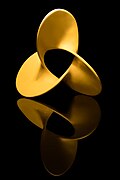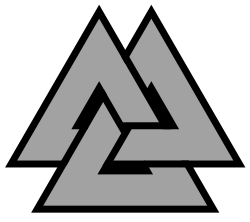Kleeblattschlinge

Die Kleeblattschlinge oder der Kleeblattknoten ist einer der einfachsten Knoten und spielt eine zentrale Rolle in der Knotentheorie. Der Knoten hat seinen Namen wegen seiner Ähnlichkeit zu Kleeblättern.
Parametrisierung und Invarianten
Eine einfache Parameterdarstellung der Kleeblattschlinge ist:
Der (2,3)-Torusknoten ist ebenfalls ein Kleeblattknoten. Die folgenden parametrischen Gleichungen ergeben einen (2,3)-Torusknoten, der auf dem Torus liegt:
Die so definierte Kurve liegt überschneidungsfrei auf dem Torus, der in Zylinderkoordinaten durch definiert ist. Damit ist die Kleeblattschlinge das einfachste Beispiel eines Torusknotens.[1]
Das Alexander-Polynom der Kleeblattschlinge ist
und ihr Jones-Polynom ist
- oder
je nachdem, ob sie rechts- oder linkshändig ist.
Die Knotengruppe hat die Präsentierung
und ist damit isomorph zur Zopfgruppe .
Das Knotenkomplement der Kleeblattschlinge ist diffeomorph zu , also dem Quotienten von SL(2,R) nach der Modulgruppe .
Symmetrie
Die Kleeblattschlinge ist chiral, d. h., sie ist nicht in ihr Spiegelbild deformierbar. Deshalb existieren zwei nicht ineinander überführbare Formen von Kleeblattschlingen. Diese werden auch rechtshändige und linkshändige Kleeblattschlinge genannt.[2]
- Eine linkshändige Kleeblattschlinge.
- Eine rechtshändige Kleeblattschlinge.
In der Kunst
Als einfacher Knoten kommt die Kleeblattschlinge häufig in der bildenden Kunst und der Ikonographie vor. So sind zum Beispiel die Triquetra und die zusammenhängende Form der Valknut Kleeblattschlingen.
- Das Logo des Deutschen Fußball-Bunds ähnelt einer Kleeblattschlinge.
- Eine Triquetra.
- Ein alter nordischer Mjöllnir, Anhänger mit Kleeblättern.
Galerie
- Ein einfaches Triquetra-Symbol
- Eine fest geknüpfte Triquetra
- Die Valknut
- Eine metallische Valknut in Form eines Kleeblattes
- (c) Matemateca (IME USP) / (name of the photographer), CC BY-SA 4.0Seifert-Fläche für eine Kleeblattschlinge.
- (c) Matemateca (IME USP) / (name of the photographer), CC BY-SA 4.0Nicht-orientierbare Fläche, deren Rand eine Kleeblattschlinge ist.
Literatur
- Max Dehn: Die beiden Kleeblattschlingen. In: Mathematische Annalen. 102, 1914, S. 402–413 (uni-goettingen.de).
Weblinks
Einzelnachweise
- ↑ uni-math.gwdg.de (PDF; 2,2 MB) Knotentheorie. Abgerufen am 3. Mai 2012.
- ↑ cut-the-knot.org über Achtknoten. Abgerufen am 3. Mai 2012.
Auf dieser Seite verwendete Medien
Autor/Urheber: Deutscher Fußball-Bund, Lizenz: CC BY 4.0
DFB Logo since November 2025
A tightly-knotted form of the Triquetra.
For a version with straight lines (not partial circular arcs), see Image:Valknut-Symbol-triquetra.svg. For curved versions of the triquetra which are not tightly knotted, see Image:Triquetra-Interlaced-Triangle-Circle.svg , Image:Triquetra-Vesica.svg , Image:Triquetra-Vesica-solid.png , Image:Triquetra-Double.svg , and Image:Triquetra-circle-interlaced.svg .(c) Matemateca (IME USP) / (name of the photographer), CC BY-SA 4.0
Orientable surface whose boundary is the trefoil knot, Matemateca IME-USP collection.
Metallic style Valknut on black background. In this version of the Valknut, the triangles are interlinked as a Trefoil knot.
A trefoil knot.
A Right-handed trefoil knot
(c) Matemateca (IME USP) / (name of the photographer), CC BY-SA 4.0
Mathematical non-orientable surface which the boundaries are the trefoil knot in different angles, object is part of the Matemateca (IME/USP) collection.
A form of the Triquetra symbol which has the exact geometrical proportions to be composed of three overlapping Vesica piscis symbols — something which is important to a few authors of books on Christian symbolism. (Ribbons version.) For other versions of the triquetra, see also Image:Triquetra-Vesica-solid.png , Image:Triquetra-Double.png , Image:Triquetra-Interlaced-Triangle-Circle.png , Image:Triquetra-tightly-knotted.png , and Image:Triquetra-circle-interlaced.png .
The six curve-intersection points define four small equilateral triangles, which make up one large equilateral triangle.



















